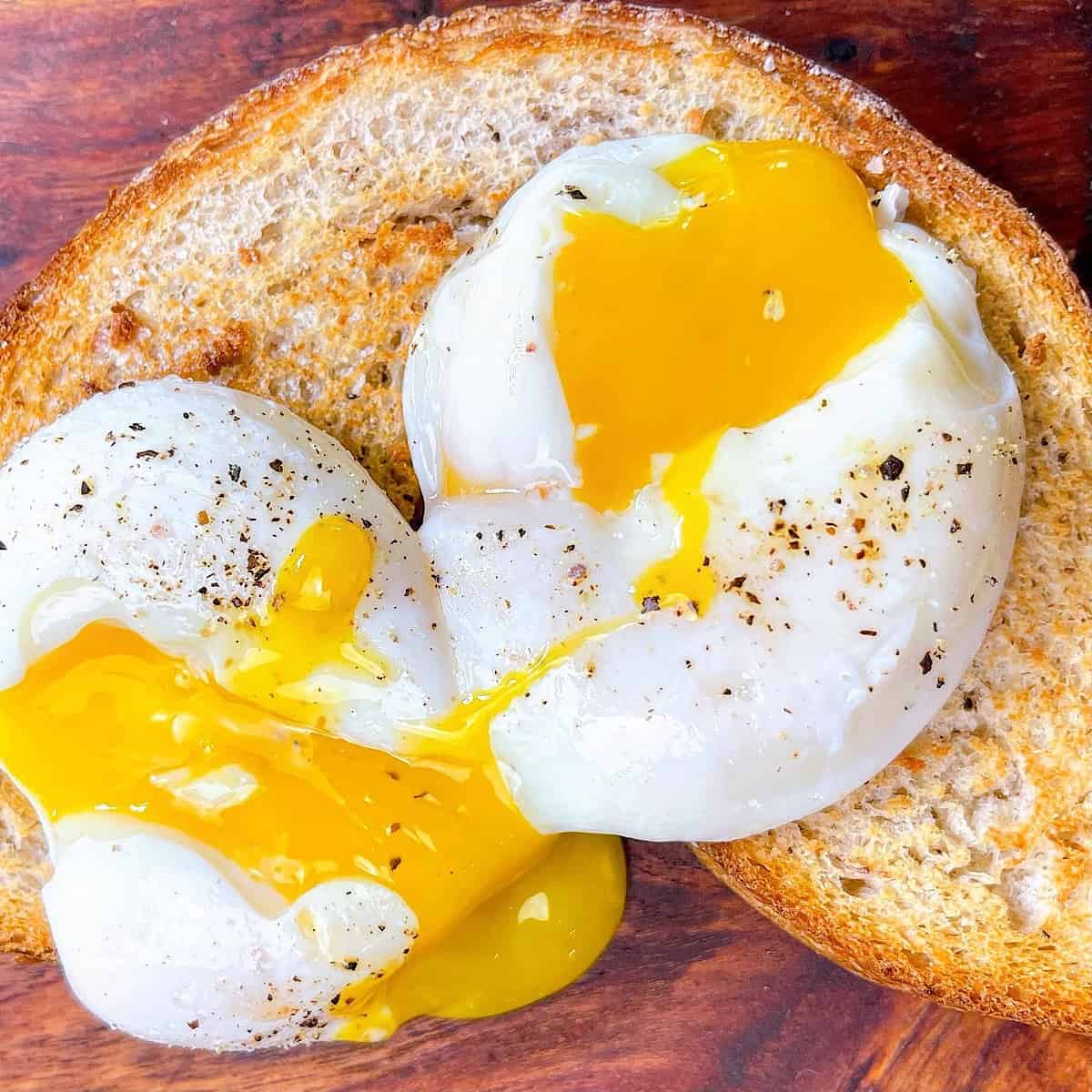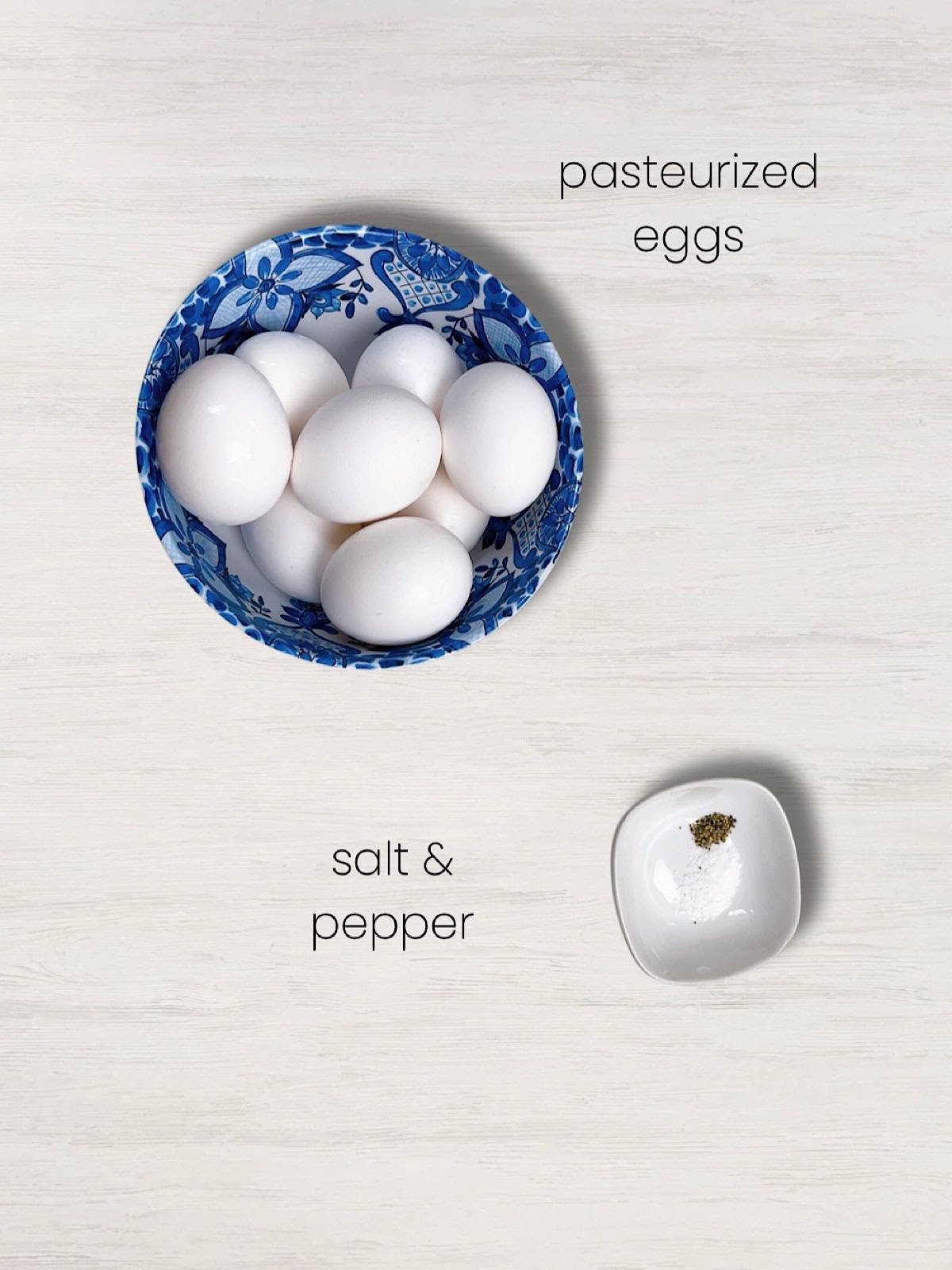Tired of guessing when your soft-boiled eggs are just right? This Sous Vide Soft-Boiled Eggs recipe takes the uncertainty out of the process, delivering perfectly runny yolks and firm, tender whites every time. Using the sous vide method, you can cook eggs directly in their shells with precise temperature control.
Our family loves to eat these eggs on homemade sourdough toast, or with this Stone Ground Grits Recipe and Cowboy Potatoes.

Save This Recipe 💌
The term "sous vide" is derived from French, meaning "under vacuum," which refers to the cooking technique where food is vacuum-sealed in a bag and cooked in a temperature-controlled hot water bath. This in-shell method eliminates the need for the bag while still allowing precise and consistent cooking.
If you like this sous vide soft-boiled egg recipe, you may also like our Bacon, Egg, and Cheese English Muffin or our Scrambled Egg Sandwich.
Why We Love This Recipe
- Effortless Cooking: Let the sous vide do the work while you prep the sides—no need for vacuum-sealed bags since the eggs cook right in their shells.
- Perfect for a Crowd: Hosting brunch? Easily cook multiple eggs at once, making it simple to serve a classic eggs benedict or a stunning breakfast spread without the hassle.
- Precision Every Time: With sous vide, there’s no guesswork. Just set the exact temperature and time for perfectly soft-boiled eggs, and they’ll turn out flawless—every single time. Love soft-boiled eggs? Try our Jammy Egg, Avocado, and Bacon Salad.
- Great for Brunch or Busy Mornings: Whether you're making eggs benedict for a gathering or meal prepping for the week, this method makes it easy to cook multiple eggs at once.
Sous Vide Soft Boiled Eggs Ingredients
Here are the basic ingredients to make soft-boiled eggs.

- Whole Pre-Pasteurized Eggs (raw eggs in shell)
- Salt
- Pepper
A full ingredient list with exact measurements can be found in the recipe card below.
How to Make Sous Vide Soft Boiled Eggs
Follow these steps carefully to get precisely cooked eggs every time.

Step 1: Par-boil eggs on the stove using a high temperature for three minutes.
While eggs are boiling, prepare a water bath by filling a large container or pot with water. Attach your sous vide machine or immersion circulator and set the temperature to 145°F (63°C).

Step 2: Remove eggs from the boiling water.
Carefully place them in an ice bath for one minute.

Step 3: Gently place eggs into the water bath, making sure they are fully submerged in the water.
Allow the eggs to cook in the sous vide water bath for 45 minutes, ensuring a consistent and precise temperature for perfectly cooked soft-boiled eggs.

Step 4: To peel the eggs, gently tap the bottom of each egg onto a hard surface to create a crack in the shell.
Peel away the outer top of the shell to expose a small hole at the top of the sous-vide egg.

Step 5: Tilt the cracked egg over a bowl, allowing the soft-boiled egg to gently slide out.
Spoon out the tight white egg from the loose membrane.

Step 6: Serve immediately while still warm.
We enjoy these jammy eggs on sourdough toast or with Cowboy Potatoes.
Expert Tips for Success
👩🍳Jami's Pro Tips: Want to take this recipe to the next level? Check out my expert tips below for the best flavor, texture, and meal prep hacks!
✔️ DO Use pre-pasteurized eggs. (See Food Safety notes below).
✔️ DO Keep an eye on the water temperature throughout the cooking process for precise results.
Storage
Store unpeeled soft-boiled eggs in an airtight container in the refrigerator for up to 2 days. To reheat, place unpeeled eggs in warm (not boiling) water for 3-5 minutes until warmed through. If already peeled, place them in a heatproof bowl and pour warm water over them, letting them sit for 2-3 minutes. Do not freeze soft-boiled eggs.
Recipe FAQs
Salmonella is typically killed when eggs are cooked to an internal temperature of 160°F (71°C) or higher.
You should consume pasteurized eggs to prevent foodborne illness, especially if you are pregnant, nursing, or have a weakened immune system.
Sous vide cooking offers precise temperature control, resulting in consistent and perfectly cooked dishes every time. It enhances the flavor and juiciness of food, as the sealed bag retains natural juices and aromas. Additionally, sous vide simplifies the cooking process, making it accessible to all skill levels.

Did You Like This Sous Vide Soft Boiled Eggs Recipe?
- Leave a ⭐️⭐️⭐️⭐️⭐️ Star Rating if think these sous vide eggs are amazing!
📖 Recipe

Sous Vide Soft Boiled Eggs (in Shell)
Equipment
- 1 Sous Vide Cooker
- Slotted spoon
Ingredients
- 8 pre-pasteurized par-boiled eggs in shell
- salt and pepper to taste
Instructions
- Gently par-boil pre-pasteurized eggs for 3 minutes in boiling water.
- While eggs are boiling, prepare a water bath by filling a large container or pot with water. Attach your sous vide machine or immersion circulator and set the temperature to 145°F (63°C). *Refer to Food Safety below.
- Remove the eggs from the boiling water and place in an ice bath for one minute.
- Carefully place the par-boiled eggs into the water bath, making sure they are fully submerged in the water. Allow the eggs to cook in the sous vide water bath for 45 minutes, ensuring a consistent and precise temperature for perfectly cooked soft-boiled eggs.
- To peel the eggs, gently tap the bottom of each egg onto a hard surface to create a crack in the shell. Then, peel away the outer top of the shell to expose a small hole at the top of the egg.
- Tilt the cracked egg over a bowl, allowing the soft-boiled egg to slide out. Spoon out the tight white egg from the loose membrane. Serve immediately.









Capt Kevin M D says
My max temp is 120 F. How long to cook for soft boiled egg ?
I thought that a much longer cook time would make up for lower temps ?
Thanks
Kevin
Jami Powell says
Thanks for your question, Kevin! It's not safe to sous vide an egg at 120°F, as that temperature is too low to kill harmful bacteria like Salmonella.
While I'm not an expert in sous vide, I’m always learning and will look into it more. For now, I'd recommend checking out Serious Eats or ChefSteps for detailed info on sous vide temperatures. Please note, I’m offering general guidance, so be sure to verify with professional sources. I appreciate you bringing this up!